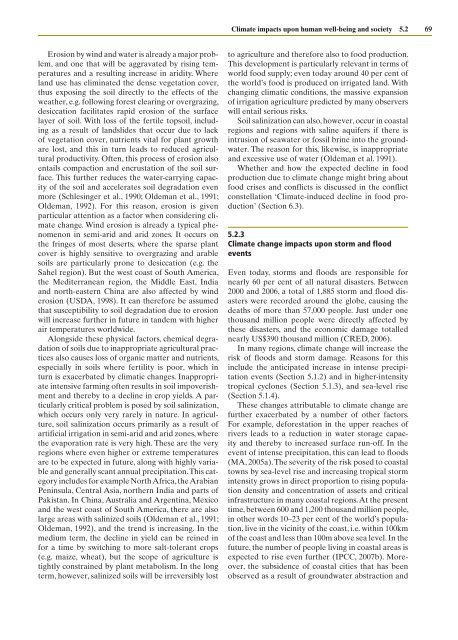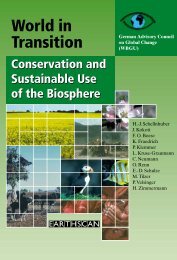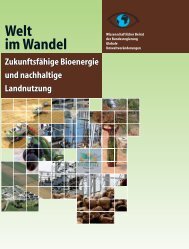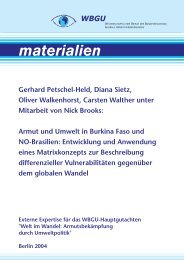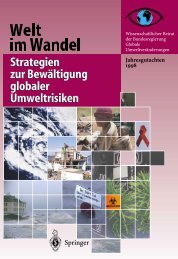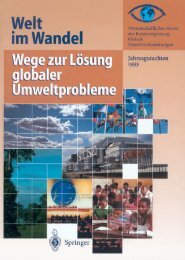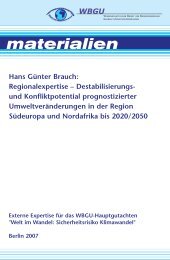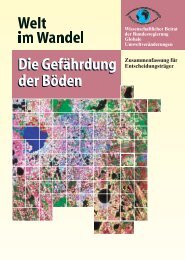World in Transition: Climate Change as a Security Risk - WBGU
World in Transition: Climate Change as a Security Risk - WBGU
World in Transition: Climate Change as a Security Risk - WBGU
You also want an ePaper? Increase the reach of your titles
YUMPU automatically turns print PDFs into web optimized ePapers that Google loves.
Erosion by w<strong>in</strong>d and water is already a major problem,<br />
and one that will be aggravated by ris<strong>in</strong>g temperatures<br />
and a result<strong>in</strong>g <strong>in</strong>cre<strong>as</strong>e <strong>in</strong> aridity. Where<br />
land use h<strong>as</strong> elim<strong>in</strong>ated the dense vegetation cover,<br />
thus expos<strong>in</strong>g the soil directly to the effects of the<br />
weather, e.g. follow<strong>in</strong>g forest clear<strong>in</strong>g or overgraz<strong>in</strong>g,<br />
desiccation facilitates rapid erosion of the surface<br />
layer of soil. With loss of the fertile topsoil, <strong>in</strong>clud<strong>in</strong>g<br />
<strong>as</strong> a result of landslides that occur due to lack<br />
of vegetation cover, nutrients vital for plant growth<br />
are lost, and this <strong>in</strong> turn leads to reduced agricultural<br />
productivity. Often, this process of erosion also<br />
entails compaction and encrustation of the soil surface.<br />
This further reduces the water-carry<strong>in</strong>g capacity<br />
of the soil and accelerates soil degradation even<br />
more (Schles<strong>in</strong>ger et al., 1990; Oldeman et al., 1991;<br />
Oldeman, 1992). For this re<strong>as</strong>on, erosion is given<br />
particular attention <strong>as</strong> a factor when consider<strong>in</strong>g climate<br />
change. W<strong>in</strong>d erosion is already a typical phenomenon<br />
<strong>in</strong> semi-arid and arid zones. It occurs on<br />
the fr<strong>in</strong>ges of most deserts, where the sparse plant<br />
cover is highly sensitive to overgraz<strong>in</strong>g and arable<br />
soils are particularly prone to desiccation (e.g. the<br />
Sahel region). But the west co<strong>as</strong>t of South America,<br />
the Mediterranean region, the Middle E<strong>as</strong>t, India<br />
and north-e<strong>as</strong>tern Ch<strong>in</strong>a are also affected by w<strong>in</strong>d<br />
erosion (USDA, 1998). It can therefore be <strong>as</strong>sumed<br />
that susceptibility to soil degradation due to erosion<br />
will <strong>in</strong>cre<strong>as</strong>e further <strong>in</strong> future <strong>in</strong> tandem with higher<br />
air temperatures worldwide.<br />
Alongside these physical factors, chemical degradation<br />
of soils due to <strong>in</strong>appropriate agricultural practices<br />
also causes loss of organic matter and nutrients,<br />
especially <strong>in</strong> soils where fertility is poor, which <strong>in</strong><br />
turn is exacerbated by climatic changes. Inappropriate<br />
<strong>in</strong>tensive farm<strong>in</strong>g often results <strong>in</strong> soil impoverishment<br />
and thereby to a decl<strong>in</strong>e <strong>in</strong> crop yields. A particularly<br />
critical problem is posed by soil sal<strong>in</strong>ization,<br />
which occurs only very rarely <strong>in</strong> nature. In agriculture,<br />
soil sal<strong>in</strong>ization occurs primarily <strong>as</strong> a result of<br />
artificial irrigation <strong>in</strong> semi-arid and arid zones, where<br />
the evaporation rate is very high. These are the very<br />
regions where even higher or extreme temperatures<br />
are to be expected <strong>in</strong> future, along with highly variable<br />
and generally scant annual precipitation. This category<br />
<strong>in</strong>cludes for example North Africa, the Arabian<br />
Pen<strong>in</strong>sula, Central Asia, northern India and parts of<br />
Pakistan. In Ch<strong>in</strong>a, Australia and Argent<strong>in</strong>a, Mexico<br />
and the west co<strong>as</strong>t of South America, there are also<br />
large are<strong>as</strong> with sal<strong>in</strong>ized soils (Oldeman et al., 1991;<br />
Oldeman, 1992), and the trend is <strong>in</strong>cre<strong>as</strong><strong>in</strong>g. In the<br />
medium term, the decl<strong>in</strong>e <strong>in</strong> yield can be re<strong>in</strong>ed <strong>in</strong><br />
for a time by switch<strong>in</strong>g to more salt-tolerant crops<br />
(e.g. maize, wheat), but the scope of agriculture is<br />
tightly constra<strong>in</strong>ed by plant metabolism. In the long<br />
term, however, sal<strong>in</strong>ized soils will be irreversibly lost<br />
<strong>Climate</strong> impacts upon human well-be<strong>in</strong>g and society 5.2<br />
to agriculture and therefore also to food production.<br />
This development is particularly relevant <strong>in</strong> terms of<br />
world food supply; even today around 40 per cent of<br />
the world’s food is produced on irrigated land. With<br />
chang<strong>in</strong>g climatic conditions, the m<strong>as</strong>sive expansion<br />
of irrigation agriculture predicted by many observers<br />
will entail serious risks.<br />
Soil sal<strong>in</strong>ization can also, however, occur <strong>in</strong> co<strong>as</strong>tal<br />
regions and regions with sal<strong>in</strong>e aquifers if there is<br />
<strong>in</strong>trusion of seawater or fossil br<strong>in</strong>e <strong>in</strong>to the groundwater.<br />
The re<strong>as</strong>on for this, likewise, is <strong>in</strong>appropriate<br />
and excessive use of water (Oldeman et al. 1991).<br />
Whether and how the expected decl<strong>in</strong>e <strong>in</strong> food<br />
production due to climate change might br<strong>in</strong>g about<br />
food crises and conflicts is discussed <strong>in</strong> the conflict<br />
constellation ‘<strong>Climate</strong>-<strong>in</strong>duced decl<strong>in</strong>e <strong>in</strong> food production’<br />
(Section 6.3).<br />
5.2.3<br />
<strong>Climate</strong> change impacts upon storm and flood<br />
events<br />
Even today, storms and floods are responsible for<br />
nearly 60 per cent of all natural dis<strong>as</strong>ters. Between<br />
2000 and 2006, a total of 1,885 storm and flood dis<strong>as</strong>ters<br />
were recorded around the globe, caus<strong>in</strong>g the<br />
deaths of more than 57,000 people. Just under one<br />
thousand million people were directly affected by<br />
these dis<strong>as</strong>ters, and the economic damage totalled<br />
nearly US$390 thousand million (CRED, 2006).<br />
In many regions, climate change will <strong>in</strong>cre<strong>as</strong>e the<br />
risk of floods and storm damage. Re<strong>as</strong>ons for this<br />
<strong>in</strong>clude the anticipated <strong>in</strong>cre<strong>as</strong>e <strong>in</strong> <strong>in</strong>tense precipitation<br />
events (Section 5.1.2) and <strong>in</strong> higher-<strong>in</strong>tensity<br />
tropical cyclones (Section 5.1.3), and sea-level rise<br />
(Section 5.1.4).<br />
These changes attributable to climate change are<br />
further exacerbated by a number of other factors.<br />
For example, deforestation <strong>in</strong> the upper reaches of<br />
rivers leads to a reduction <strong>in</strong> water storage capacity<br />
and thereby to <strong>in</strong>cre<strong>as</strong>ed surface run-off. In the<br />
event of <strong>in</strong>tense precipitation, this can lead to floods<br />
(MA, 2005a). The severity of the risk posed to co<strong>as</strong>tal<br />
towns by sea-level rise and <strong>in</strong>cre<strong>as</strong><strong>in</strong>g tropical storm<br />
<strong>in</strong>tensity grows <strong>in</strong> direct proportion to ris<strong>in</strong>g population<br />
density and concentration of <strong>as</strong>sets and critical<br />
<strong>in</strong>fr<strong>as</strong>tructure <strong>in</strong> many co<strong>as</strong>tal regions. At the present<br />
time, between 600 and 1,200 thousand million people,<br />
<strong>in</strong> other words 10–23 per cent of the world’s population,<br />
live <strong>in</strong> the vic<strong>in</strong>ity of the co<strong>as</strong>t, i.e. with<strong>in</strong> 100km<br />
of the co<strong>as</strong>t and less than 100m above sea level. In the<br />
future, the number of people liv<strong>in</strong>g <strong>in</strong> co<strong>as</strong>tal are<strong>as</strong> is<br />
expected to rise even further (IPCC, 2007b). Moreover,<br />
the subsidence of co<strong>as</strong>tal cities that h<strong>as</strong> been<br />
observed <strong>as</strong> a result of groundwater abstraction and<br />
69


